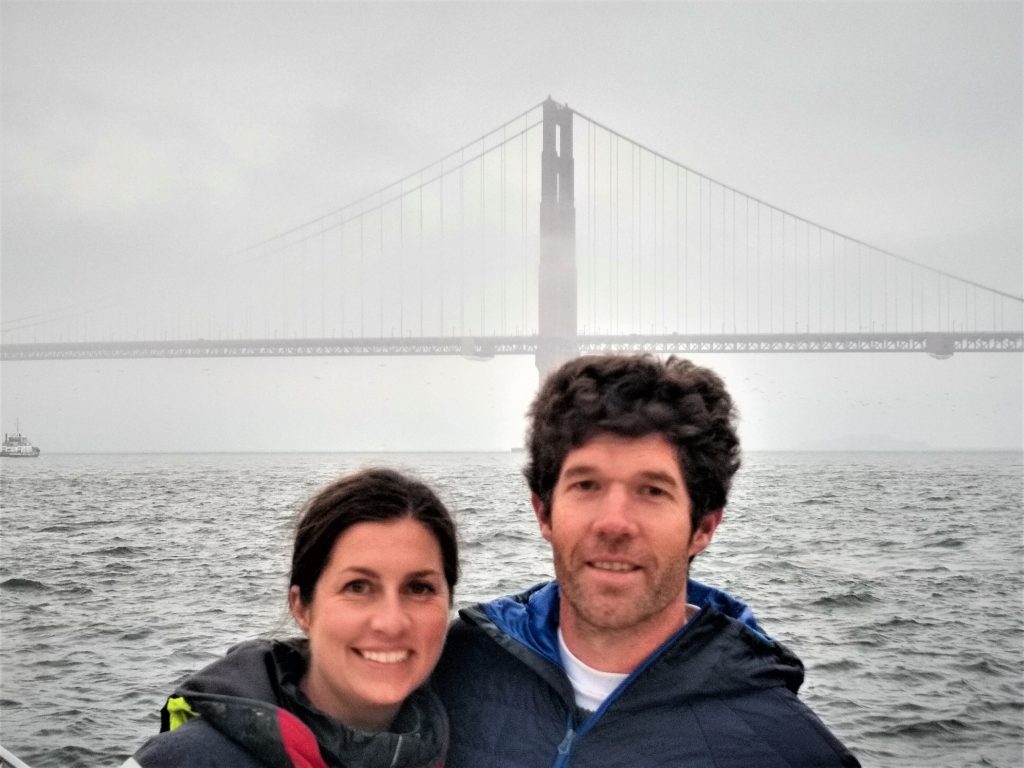
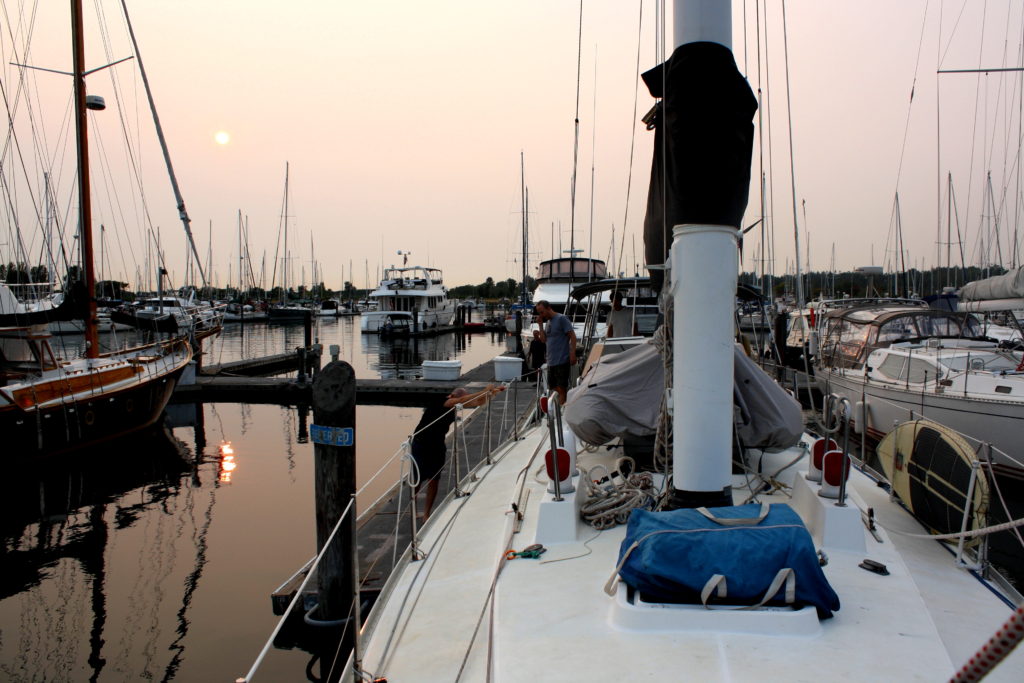
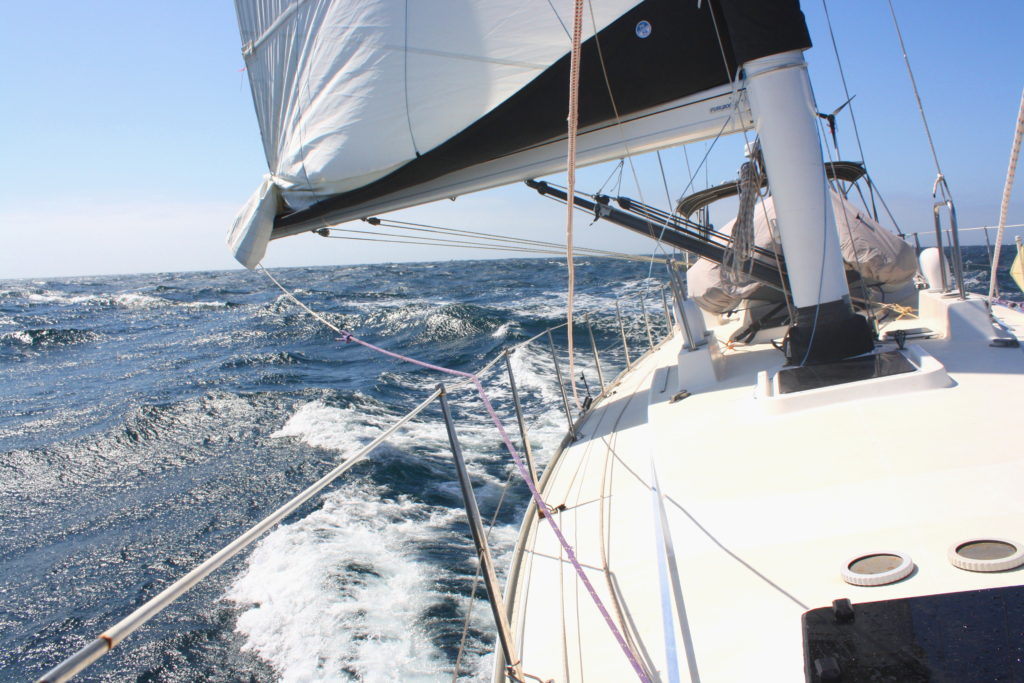
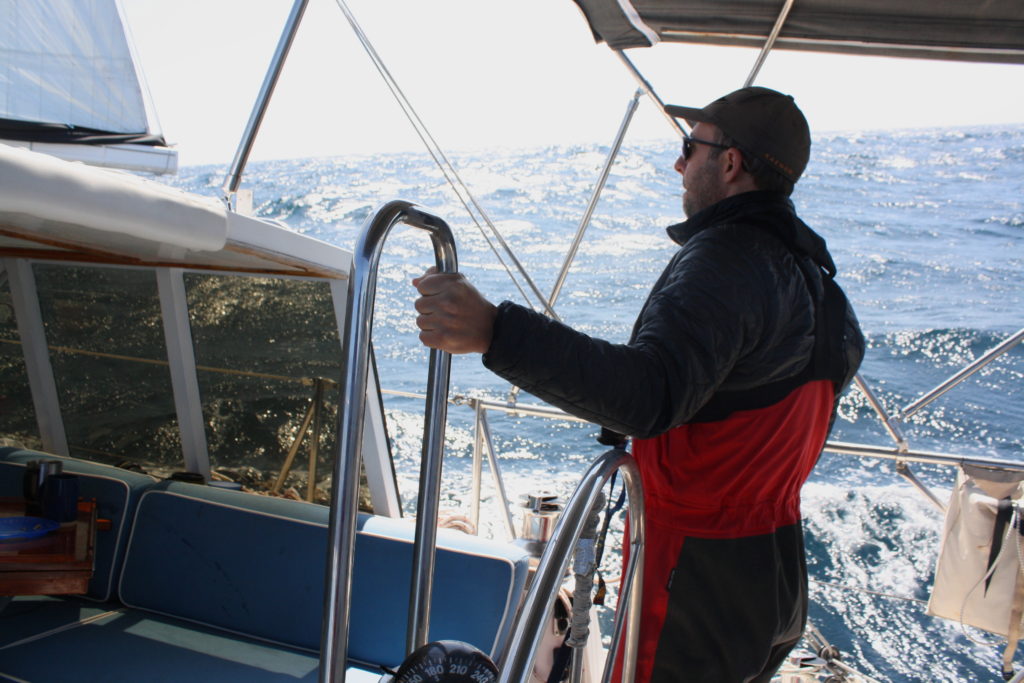
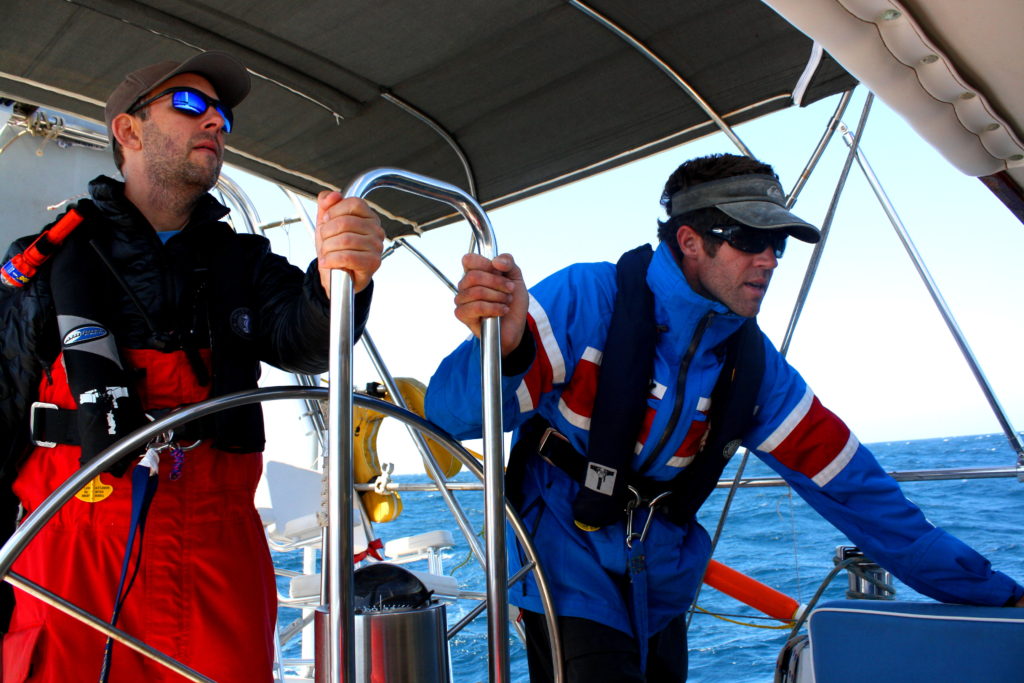
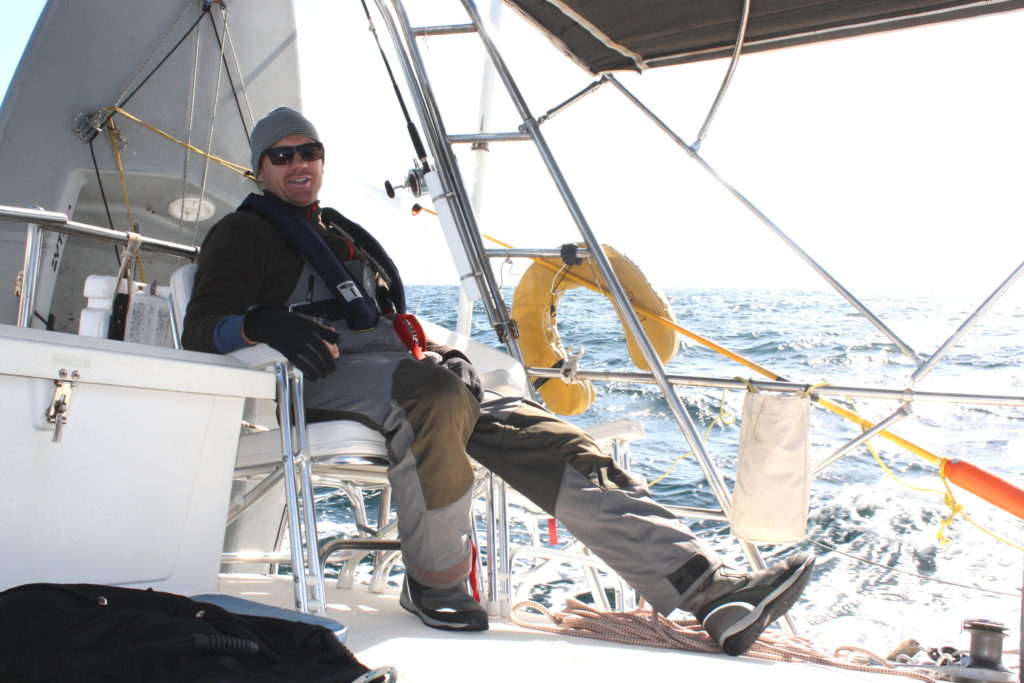
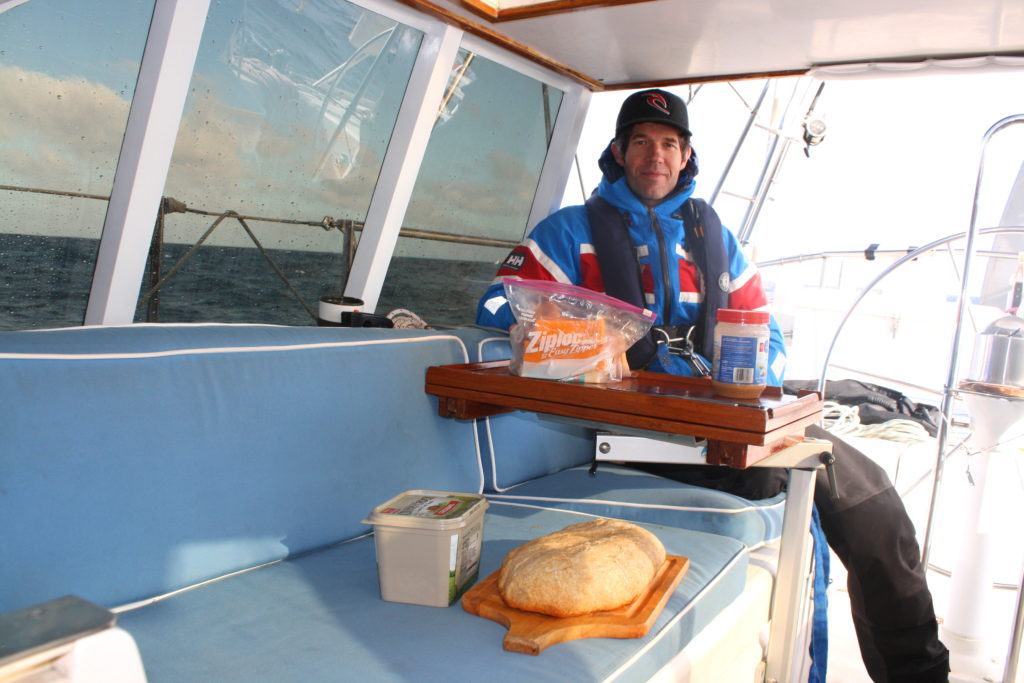
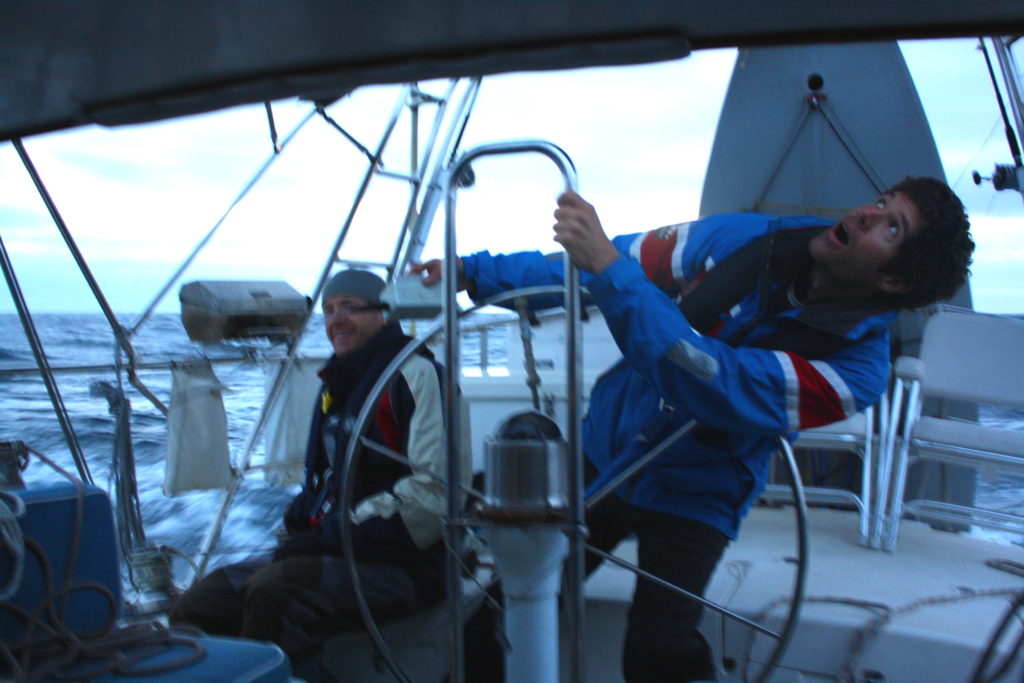
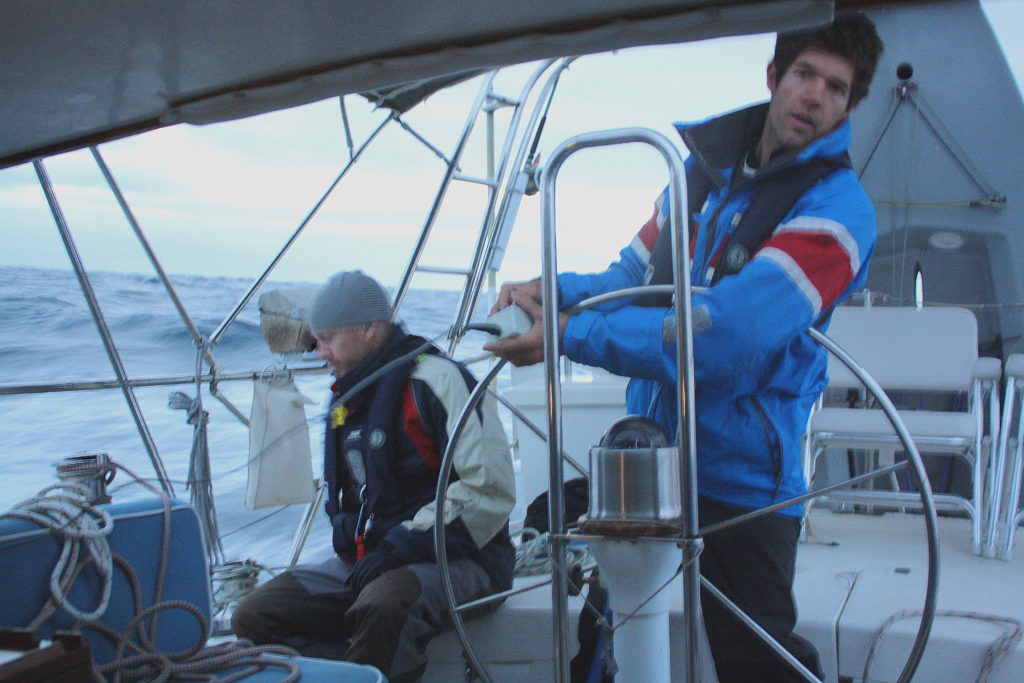
I am pleased to report that we had a successful first passage – Point Roberts, Washington to San Francisco! Thank you to Don and Jer who were fabulous crew and ably helped us safely navigate this tough stretch of formidable coastal waters. We had lots of laughs, midnight snacks (thanks Jer) and some adventure (46 knot puffs anyone?). It also helped me learn about the boat, keep a solo nighttime watch, and how to prepare meals while rocketing downwind in rolly seas and big waves.
Overview
- Time – 6 days including a brief overnight at anchor while we waited for favourable wind and current at Race Rocks
- Distance Traveled – 800 Nautical Miles as the crow flies, but we covered much more distance than this as we gybed down the coast
- Top Speed – 17.8 Knots. This is a new speed record for Slingshot
- Top Wind Speed – 46 knots as recorded on our anemometer.
- Wildlife – Sea Lions, Whales, Dolphins, a shark, sea birds including pelicans and a midnight visitor that explored our engine room!
- Biggest Wave – Subjective and difficult to measure but we estimate 20 feet. Gav reports it was quite a sight to be at the helm as we careened down waves with water shooting off either side of the hull and half the boat was out of the water and we still had half of the wave to go down. (While this happened, Don Jer and I were quietly discussing what to do if we broached and ensuring that Gavin kept fed and watered)
- Funniest Moment: Jer, Don and me hucking it up in the cockpit while Gavin was sleeping as we almost broached while Jer encouraged me to take over steering using the autohelm ‘dial’ while the spinnaker was up. In slow motion Jer took over the steerage to avoid a broach while we couldn’t stop laughing and Gavin woke up from his nap to demand what the heck we were doing out there! Mastering the dial will take some time!
Leaving the Dock!
We left the dock at sunset after a very busy day doing last minute errands – provisioning, picked up our storm jib, propane, affixing the byte, tying down the dinghy and countless other details. The last thing to take care of was for me to drop off our vehicle in Canada for my sister to pick up. I had a fun ride on a razor skooter through the border and down the road to the marina in Point Roberts taking in the last gazes and smells of 49 degrees north for a while!
Untying the dock lines was something we have been working towards for a long time and it was an amazing feeling to finally pull away. We enjoyed the moment for a few minutes and then nervous excitement took over as we looked ahead to navigating through the San Juan islands at nightfall. We wanted to take advantage of the considerable tide and current that was going in the same direction we were. Waiting until the morning would have meant pushing against a 1-2 knot current.

AIS – We Love you!
Thank goodness for AIS (Automatic Identification System). It is a system that allows yachts to register and broadcast their vessel information so that other yachts nearby can see them. Very helpful for peace of mind at night or in fog – anytime there is limited visibility. Our chart plotter (on our Ipad) lit up with AIS signals from various boats as we navigated in darkness. We had one commercial freighter call us on the VHF as we rounded a headland and he coached us to pass each other “red to red” in the darkness. (Red in sailing means port or left side and this means that we would pass each other with our red lights showing).
Jer reasoned that the experienced ship captain boiled down the communication to the simplest possible message as he watched us on a collision course for his yacht and wondered when we planned on turning!
We had some large waves and current as we refreshed our nighttime navigational skills looking at lighthouses and flashing buoys navigating up the coast near to race rocks. Then Gavin and Don took over and we anchored briefly overnight as we did not want to deal with the strong wind, current and waves rounding race rocks in the darkness.
The next day we sailed up the Juan de Fuca in 15 to 25 knots with large swells and rounded Cape Flattery by nightfall. Then it was time for our first nighttime shifts solo!
Shift Schedules:
Our nighttime shift schedule was:
- Gavin – 10 to 12 am
- Don – 12 to 2am
- Jenn – 2 to 4am
- Jer – 4 to 6 am
Our loose daytime shifts had Gavin covering the 6am to 10am, Don 10am to 2pm, Jenn 2pm to 6pm and Jer from 6pm to 10pm. Overall this worked well and I am curious as to how Gavin and I are going to manage on our own!
The stars were amazing and we saw many shooting stars while listening to the swish of the water behind us as we sailed into the darkness. I was nervous for my first solo shift, but took great confidence in the autopilot who we have named “George Will Helm the Third” as well as the AIS and chart plotting software that tells us our speed over ground and where we are in relation to the chart and other boats. The only wild card is that not all boats have AIS – or if they do have AIS- some fishing boats turn it off so that they don’t alert their competition where the fish are – not great for us!
Those waves are small?
We were happy to see lightfall and it was the first time I had seen real ocean swell during the daylight as I had slept through our cape flattery rounding and only felt the swells at night. I looked out the hull windows as I made breakfast and commented to Gavin that the waves were ‘really big’. He just looked at me and said, “Jenn, this is nothing! These waves are small!” I was surprised and a bit concerned to hear this!
We had a great day making headway offshore out to see, averaging 8 knots in 17 to 22 knots of wind. Beautiful sailing. We used our spinnaker during the day and then put the jib up overnight with one reef in the main. We are very pleased with our new jib which has us making fantastic upwind pace!
We continued on for a couple of days and had lots of fun rotating through our shifts and I made lots of yummy food – I’d cooked a green curry and chili ahead while the boat was flat and was happy to make use of these meals when the seas got bumpy! I also made no-knead bread which has been a hit. Another recipe to come!
Iridium Go! and Predict Wind – Thumbs up!!
We used our Iridium Go! to use satellite connection to download weather twice daily. The PredictWind offshore sailing app worked flawlessly on our Ipad – downloading 4 weather grib files to our computer, then using the ‘polars’ we in input for the boat to calculate the best route for us to sail. This is all fed on to a user friendly colour coded chart showing various wind speeds. In general we were trying to stay in the blue to yellow (5- 20 knot range) and avoid the red zone (20 knots plus). There is even a ‘comfort route’ that you can program so that you can ask to plot a route that will not take you into any wind above 25 knots!
Unfortunately there was a red zone developing off the coast near Cape Mendocino (notoroiously windy area north of San Francisco) that we wanted to avoid. The models were showing lighter air close to shore and so we decided to gybe from our approximately 100 mile offshore position to head on a bearing closer to shore and then possibly stop in along the coast to wait a day.
Dolphins and Sea Lions!
We sailed overnight closer into shore and the wind dropped considerably and the sun came out. The overnight sailing was a bit hairy with a number of fish boats who had turned off their AIS scattered throughout our path. Luckily they appeared to ‘see us’ on AIS and all avoided us. It still made the night time watch a bit hair raising as we saw these white glowing blobs in the darkness around us.
In the morning we awoke to a large pod of dolphins and a sea lion that were fishing and frolicking all around our boat. We enjoyed the calm seas to relax on the deck taking in the beautiful sounds and sights.
Jer managed to wake himself for the last few dolphin sightings.
We decided to gybe back out into the stronger breeze and gybe back when the wind got stronger.
5 to 15 knots – or wait, did he say 5 to 50 knots?
We listened to the marine broadcast in addition to using our predict wind forecasts. There was a broad forecast for 5 to 15 knots or was it 5 to 50 knots for a long stretch of the California Coast. I swear I heard 5 to 50 knots while the rest of the crew assured me it was only 5 to 15…
We had a lovely evening dinner of steak behind the dodger as we hit 11.2 knots with a double reefed main enjoying the sunshine.
The next day, we knew we were going to hit some wind but were planning on 25 knots with probably a few stronger gusts. Jer and I were taking our shift downstairs with Jer peering out the window as the wind increased. Gavin yelled out that we hit a new top speed. When Jer asked what the wind speed was, Gavin didn’t answer.
“Cape Menace”
We all clambered on deck and could all see that the swells were getting larger and the wind increasing. I was seeing 28knots to 33 knots on the anemometer. I took a few pictures while Jer and Gavin discussed what would happen if the autopilot gybed the boat – would it immediately gybe back to keep us on course?
Then Gavin asked me to get out the manuals on how exactly the yaw adjustment scale of 1-12 impacts the autohelm. When the autopilot began to spin the wheel as we zoomed down larger and larger waves, Gavin grabbed the helm and we all held on for the ride.
Don called the waves so that Gavin knew when the big ones were coming. Jer and I watched the wind and knotmeter rise to bigger and bigger highs as we discussed routing options to get out of the wind.
The gusts were loud and rattled the boat. The wind was blowing the tops off the whitecaps and the waves were huge! Gavin did a tremendous job of steering us through the waves. A few waves slammed the dodger with considerable force and we were very happy to be protected in the dodger!
After a few hours of strong wind we were happy when the wind decreased and the sun came out closer to shore. Cape Mendocino or Cape “Menace” as I like to call it really lived up to its reputation.
Jer saw 46 knot puffs and our top speed was 17.8 knots going down a wave! This was not the 25 knots forecast by our weather model or the onshore weather forecasting – or wait was this the 5 to 50 knot forecast they give down this stretch of coast!! We concluded that the topography of the cape contributed to the local patch of very strong winds that we ended up sailing through. Yikes!

Gavin – What’s wrong with the engine?
After things calmed down we relaxed in the sunshine. As we neared San Francisco, the fog rolled in and the wind decreased. We turned the motor on and looked forward to our final evening shifts before arriving in San Francisco.
At 3am midway through my shift, the engine stopped. Just died. I nervously called for Gavin and he bolted awake and jumped down into the engine room to see what was going on.
Quickly he identified the gauge which indicates how much work the engine needs to do to pull fuel through the filters into the engine…the gauge had spiked. Quickly Gavin and Jer worked to replace the fuel filters – three in total. Each time bleeding the engine to try to suck the new fuel into the engine and let the air escape. No easy task! 3am turned into 4am turned into daylight. The engine wasn’t running. We were worried the starter engine would burn out. There was no wind and luckily no swell. We all agreed that the circumstances of this engine issue could have been much worse. Gavin patiently worked away at trying to get the engine to run. Jer and I quietly pondered plans b, c and beyond and none were appealing. We were ready to be in San Fran. We were all tired!
At about 7am Gavin asked me to check the fuel levels in each tank. I did. And guess what – one of the tanks had run out of fuel! We had measured before we left and the port tank was still showing ¾ full. This was after Gavin had motored part way home from Hawaii last summer. We didn’t think that the time motoring on this trip would have eaten through the gas already!
Sure enough, Gavin switched over the tanks, bled the fuel lines (no problem this time!) and turned over the engine. Thank goodness she started easily and we all breathed a huge sigh of relief!
Is that a bird?
At some point during all of the engine kerfuffle – when it was pitch black – Gavin looked up and we saw a sea bird flapping in under the dodger and straight into the engine room! Seriously? Luckily the bird was tired and Gavin was able to catch it and throw it into the night. Wait – he threw it straight into the other engine room hatch. I dove down and managed to capture this small fluffy seabird and throw it into the night with a puff of feathers. We all enjoyed a good laugh while we continued to troubleshoot the engine issue.
Golden Gate Arrival!
After a good sleep Gavin woke up and installed a new sump for the aft shower. Then we all enjoyed hot showers. After many more hours of motoring we were finally in the last stretch approaching the Golden Gate Bridge. It emerged out of the fog and was a beautiful sight! It was so rewarding to reach this milestone after a long passage. We pulled into anchorage in Richardson Bay, Sausalito and enjoyed a well deserved night cap at the Sausalito Yacht Club.
In all it was a successful first passage and we had lots of good times laughing and sailing our way down the coast. Thanks again Jer and Don – it was tonnes of fun!













great to sea you are living the dream. all the best from the Hansell familiy
What a great blog! 17.8 knots, you must have felt like you were flying! Only a week in and you have already had such an adventure.
Thanks for keeping us all up to date and sharing your adventurous life. Looking forward to more blogs and pictures and wishing you all the best!
Teresa
Thanks Teresa! So glad you are following along with us. Yes I am not sure if we will hit 17 knots again on our trip and that would be fine with me!! Take care and hope all is well with you. I miss BCIT! Jenn
Wow ….what an adventure ! ! I loved reading your blog and am looking forward to the next chapter.
Xx
Heather and I enjoyed your trip down to SF. We came under the GGB at midnight at 9 knots. I have asked Bernie if anyone is travelling down to see you before u leave SF who could take our book, So Where Do You Go At Night, which is about our South Seas trip and back up to Glacier Bay. You might find it useful. Please include us in your news. Do not know size of Slingshot.
Hi Patrick – so great to hear from you! Doreen gave us a copy of your book before we departed and Gavin and I both enjoyed reading it. Wow! We are so impressed with all of your adventures and amazed at all of the effort you put into building your boat and then setting sail. We are inspired by your navigation using the sextant and have purchased our own. We love that you are following along and I know I will be turning back to pages in your book when we visit the same spots. Thank you for writing about your journey and sharing it with us! Slingshot is 60 feet – there is a bit more information about her in the ‘about’ section on the blog. Thanks again for following along with us!
Wow Jenn and Gav!! This is an amazing story… so happy you guys made it and what an incredible trip!! So cool.. we are thinking about you lots!!!! Keep the posts coming..they are great. Miss you, KK and Brett.
Thanks KK! Love hearing from you! Say Hi to Brett and family for us. XO J
Glad that you made it safely – sounds like a good baptism.
Thank you Cosmos and Donna – Was great to meet you. And thank you for the tips on freezer and boat organization! They have come in handy already! J and G
The farkwar still has you in Point Roberts. I am glad you made it to San Francisco safe and sound.
Thank you Wendy! I forgot to update Farquar and will do so again shortly! Love that you are following along! Miss you! xo J
Yay! congrats Jenn!
I can’t believe how much you all have conquered already!
Enjoy Cali, and I’m sure you have missed your babies, so catching up and doing Disney and less stressful kid things are well deserved after that passage!
I’m enjoying the blog and am learning lots of boat lingo/terminology! Great job!
Thank you Meena – Love that you are following along. I miss you and team! I will try to keep the sailing lingo understandable! J
Interesting and exciting read you guys. What a huge adventure. Loving following your progress on the blog. Have fun.
Love Duncan
Thanks Duncan! J